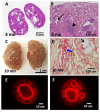Tensins in Kidney Function and Diseases
- PMID: 37374025
- PMCID: PMC10305691
- DOI: 10.3390/life13061244
Tensins in Kidney Function and Diseases
Abstract
Tensins are focal adhesion proteins that regulate various biological processes, such as mechanical sensing, cell adhesion, migration, invasion, and proliferation, through their multiple binding activities that transduce critical signals across the plasma membrane. When these molecular interactions and/or mediated signaling are disrupted, cellular activities and tissue functions are compromised, leading to disease development. Here, we focus on the significance of the tensin family in renal function and diseases. The expression pattern of each tensin in the kidney, their roles in chronic kidney diseases, renal cell carcinoma, and their potentials as prognostic markers and/or therapeutic targets are discussed in this review.
Keywords: CTEN; cancer; cystic kidney; focal adhesion; nephrotic syndrome; tensin.
Conflict of interest statement
The authors declare no conflict of interest.
Figures




References
Publication types
Grants and funding
LinkOut - more resources
Full Text Sources

